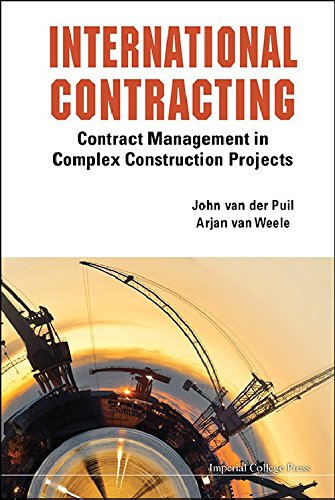International Contracting Contract Management in Complex Construction Projects 1st Edition by John Van Der Puil, Arjan van Weele 9781908979520 1908979526
$50.00 Original price was: $50.00.$35.00Current price is: $35.00.
International Contracting Contract Management in Complex Construction Projects 1st Edition by John Van Der Puil, Arjan van Weele – Ebook PDF Instant Download/Delivery: 9781908979520, 1908979526
Full download International Contracting Contract Management in Complex Construction Projects 1st Edition after payment

Product details:
ISBN 10: 1908979526
ISBN 13: 9781908979520
Author: John Van Der Puil, Arjan van Weele
This book, about international contracting and contract management, is written from the angle of the contractor and discussed from an international perspective. It comments on real-life cases, taken from various kinds of projects: infrastructural works (roads, bridges, tunnels, rail roads), wind- and sunfarms, oil and gas installations, such as platforms, pipe lines, power generating works, and large buildings.The book is structured around the contracting cycle. Chapters include dealing with the role of the contractor in international contracting, the tender process, landing and negotiating the contract, types of contract, problems that may occur during project execution, project delivery, and handling guarantee claims.Written primarily for business practitioners operating in the international contracting industry, the title assumes that the reader will have a basic understanding and knowledge of theories related to project management, construction engineering, business law and economics.Though not an academic book, due to its unique blend of practitioners’ insight and academic theory, it can be taught on Masters courses. As most engineers are going to deal with contracts, this book is specifically recommended for engineering programs at both graduate and postgraduate levels. Lawyers will find the book useful in helping them to understand the business context in which their customers and/or colleagues work.
International Contracting Contract Management in Complex Construction Projects 1st Table of contents:
Part I International Contracting: Defining the Playing Field
Chapter 1 International Contracting: How a Project Can Turn into a Nightmare
1.1. Case — An uneasy event
1.2. The BP oil spill: what happened?
1.3. The test
1.4. The first investigations
1.5. The blame game
1.6. Kinds of damages caused by the disaster and claims
1.7. Court proceedings
1.8. Further investigations and reports
1.9. What went wrong? — The causes and proposed reforms
1.10. Violation of laws, regulations, procedures and policies
1.11. Sharpening regulations
1.12. Causality and risks
1.13. Conclusions
Chapter 2 The Role of Contracting in International Contracting
2.1. Case — What is reasonable?
2.2. Changing relationships in international contracting
2.3. Contract management and contracts
2.4. The role of project managers and contract managers
2.5. Conclusions
Chapter 3 The Client
3.1. Case — No discrimination
3.2. Private sector
3.3. Public sector
3.4. Public–private partnerships
3.5. Working with clients: specific issues
3.6. Conclusions
Chapter 4 Contract Management: Definitions, Concepts and Perspectives
4.1. Case — The Amsterdam underground metro line
4.2. Contract management: concepts and definitions
4.3. Problems in contract management
4.4. Perspectives on contract management
4.5. Attitudes towards contracting
4.6. The lifecycle of a contract
4.7. Conclusions
Part II The Contracting Cycle
Chapter 5 From Tender to Final Payment
5.1. Case — The offer and the main subcontractor
5.2. The contracting lifecycle
5.3. Invitation to tender: the tender process
5.4. Landing the contract: the Letter of Intent (LOI)
5.5. Contract negotiations and closure
5.6. Subcontracting and project execution
5.7. Testing, delivery and payment
5.8. Claims and dispute resolution
5.9. Summary
Chapter 6 European Tendering
6.1. Case — Objectives
6.2. Principles and scope of the European procurement laws and directives
6.3. European procurement procedures
6.4. Implications for contractors
6.5. Summary and conclusions
Chapter 7 Downstream Contracting: Managing Suppliers and Subcontractors
7.1. Case — The subcontracted steel piles
7.2. Downstream contracting: definitions
7.3. Purchasing process and procedures
7.4. Portfolio management and supplier segmentation
7.5. Specific operational and legal problems related to procurement and subcontracting
7.6. Summary
Chapter 8 Contract Models in International Contracting
8.1. Case — The missing rescue boat
8.2. Pricing in contracts
8.3. Payment terms
8.4. Activities and risk allocation
8.5. Standard contracts
8.6. Contract models overview
8.7. How standard contracts are used
8.8. Collaborative contract models
8.9. Summary
Part III Project and Risk Management
Chapter 9 Risk Management in Projects
9.1. Case — Contractor withdraws from negotiations due to risk exposure
9.2. The many faces of risk
9.3. Definition of risk
9.4. Risk management and contract type
9.5. Risk policy of contractors
9.6. Identification of risks
9.7. Categorization of risks
9.8. Managing risks
9.9. Contract cycle and risk management
9.10. Risk appetite — risk pressure — risk exposure
9.11. Strategic risks
9.12. Conclusions and recommendations
Chapter 10 Managing Variations in Contracts
10.1. Case 1 — Permission for a technical variation
10.2. Case 2 — Instructions versus variations
10.3. Definitions of variations
10.4. Events resulting in variations
10.5. How to handle variations
10.6. Refused variations and disagreements
10.7. Variations that usually do not change contracts
10.8. Variations that changed contracts
10.9. Variations that change the typology of the contract
10.10. Conclusions
Part IV Legal Issues in International Contracting
Chapter 11 Letter of Intent and Memorandum of Understanding
11.1. Case — The missing reports and the missing permits
11.2. Letter of Intent — definition
11.3. Is a Letter of Intent legally binding?
11.4. Letter of Intent — validity and risk
11.5. Memorandum of Understanding — definition and objectives
11.6. Differences and similarities between LOI and MOU
11.7. Letter of authorization and other letters
11.8. Conclusions
Chapter 12 Signing the Contract — Pitfalls
12.1. Case — Post-tender additional work
12.2. Inaccurate technical negotiations and discussions
12.3. The objective of the four corner contract
12.4. Priority of documents
12.5. Conclusion — A few days of painstaking work
Chapter 13 Liability Versus Responsibility
13.1. Case — A loss-making project and its malfunctioning project manager
13.2. The project manager’s labor contract
13.3. The contractor’s construction contract
13.4. Legal liabilities after unlawful actions
13.5. Indemnities
13.6. Non-contractual damages
13.7. Direct versus indirect or consequential losses
13.8. Damage to contractual parties
13.9. Negligence
13.10. Insurances
13.11. Conclusions
Chapter 14 Guarantees and Warranties
14.1. Case — Guarantee issues
14.2. A guarantee by a third party
14.3. Bonds
14.4. Guarantee and good workmanship
14.5. Warranties
14.6. Decennial liability
14.7. Summary and conclusions
Chapter 15 Contract Law and Tort Law
15.1. Case — The polluted drinking water
15.2. Tort, tort law and contractual stipulations
15.3. Tort in general civil law
15.4. Applicable theory
15.5. The practical descriptions of standard contracts
15.6. Conclusions
Chapter 16 Consequential Losses
16.1. Case — The broken mill shaft and the remover
16.2. Liability for consequential losses and contract agreements
16.3. Excluding consequential losses in construction contracts
16.4. Considerations of direct versus consequential under English law
16.5. Economical losses
16.6. “Consequential” losses under the law of the Netherlands
16.7. Legal systems other than English law and the law of the Netherlands
16.8. Drafting clauses on limitation of liability
16.9. Conclusions
Chapter 17 Intellectual Property
17.1. Case — Inability to perform scope of work due to patent protection
17.2. What is a patent?
17.3. Intellectual property and tort
17.4. Patent and patent holder
17.5. Architect’s copyright
17.6. Infringement and enforcement
17.7. Confidential information and intellectual property in contracting
17.8. Conclusions
Chapter 18 Damage and Causality
18.1. Case — Malfunctioning struts
18.2. Damages under contracts
18.3. Causes of damages and losses
18.4. A theory of causality in business law
18.5. Conclusions
Chapter 19 Knock-For-Knock Arrangements
19.1. Case — The oil platform’s broken anchor chain
19.2. Liability for damages in standard contracts
19.3. The offshore industry – deviating stipulation
19.4. Example from standard non-construction contract
19.5. Himalaya clause
19.6. The purpose of the knock-for-knock principle
19.7. The unseaworthy tug boat and the gross negligence
19.8. The Piper Alpha
19.9. Further cases of knock-for-knock
19.10. A bridge too far
19.11. Negligence, gross negligence and willful misconduct
19.12. Negligence in legal systems other than common law
19.13. Preparing a tender with the knock-for-knock principle
19.14. Conclusions
Chapter 20 Disasters, Damage and Public Investigations
20.1. Case — The collapsed roofs in the Netherlands
20.2. Disasters and public investigations
20.3. Safety built into construction works — public rules and regulations
20.4. Learning from damages and disasters
20.5. Complexity of many simultaneous causes
20.6. The Twin Towers in New York
20.7. The legal importance of distinguishing different causes
20.8. Holding the offender accountable in civil law and public law
20.9. Conclusions
Chapter 21 Force Majeure
21.1. Case — The loose pontoons
21.2. What is force majeure in international contracting?
21.3. Some definitions from standard contracts
21.4. Force majeure in the Netherlands’ law
21.5. Force majeure in English common law
21.6. Consequences of force majeure
21.7. The Hurricane Protocol
21.8. Conclusions
Chapter 22 Bribery
22.1. Case — The happy man
22.2. Bribery and corruption
22.3. Analyzing the small bribe
22.4. The worldwide war against corruption
22.5. The UK Bribery Act 2010
22.6. Anti-corruption legislation in the Netherlands compared with the UK
22.7. Diverse legislation and anti-corruption committees
22.8. Business reality
22.9. How to operate in a faraway country
22.10. Conclusions
Chapter 23 Dispute Resolution Mechanisms
23.1. Case — A different time schedule
23.2. What to do when you are summoned to court
23.3. Going to court yourself
23.4. Some dispute resolution clauses in standard contracts
23.5. Alternative Dispute Resolution (ADR)
23.6. Conclusions
Chapter 24 Different Legal Systems
24.1. Case — Exact to specification, but not fit for purpose
24.2. English terminology and international construction contracts
24.3. The human need for rules
24.4. Families of legal systems
24.5. The Roman civil law system
24.6. Codification of laws on the continent — law review in selected countries
24.7. Common law — the English legal system
24.8. A short comparison between common law and continental law
24.9. Various other families of legal systems
24.10. Conclusions
Chapter 25 Cultural Differences and Contract Management
25.1. Case — Two cultures meet
25.2. Introduction
25.3. Cultural differences are all around us
25.4. Defining culture
25.5. Differences of all kinds
25.6. Culture — What is behind attitude and behavior?
25.7. Characteristics of cultures and nations
25.8. Evaluating cultural aspects according to Hofstede
25.9. The practical use of cultural elements
25.10. Changing patterns
25.11. Legal reflections on cultural beliefs and assumptions
25.12. Coming to terms with different cultural values
25.13. Summary, recommendations and gentle suggestions
People also search for International Contracting Contract Management in Complex Construction Projects 1st:
international contractor agreement
international contract assembly group
international contractor agreement template
international contract agreement
international contract agency logo
Tags: International Contracting, John Van Der Puil, Arjan van Weele



